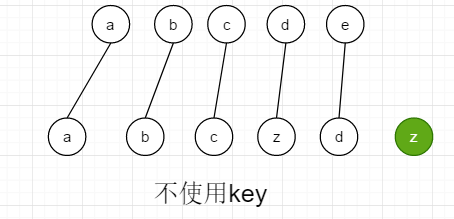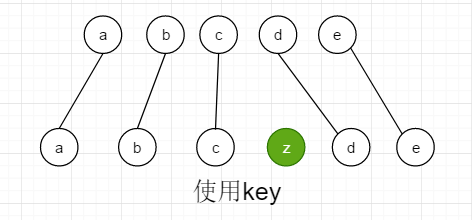如当我们想在a,b,c,d,e这四个节点的d之前c之后插入一个z节点。(diff算法源码详见后续updateChildren)

如上图所示,当我们不是给于key值的时候,由于没有key值不知道当前具体在更新谁,因此做的操作就是见到谁就更新谁。具体过程:先更新a,b,c(这三个的跟新同有key值更新操作一样),但因为没有key值到d的时候不清楚是不是自己(后续sameVnode方法中key均为undefined,tag等其他信息却一致返回true),但只能认为是自己,所以只好覆盖更新再把后的e更新到d,更新完后再创建新的追加到后面。在这个过程中进行了五次更新操作,一次追加操作。

上图是使用key值的情况,前三个一样不再说,到d和z比较时发现不一样,由于源码中首尾判断假猜策略发现尾部的e和d对应相同,就从后开始更新,到最后只剩下z,再最后创建新的z追加到相应位置(c的后面)。在这个过程中也进行了五次更新操作,一次追加操作。
那么照操作次数来看难道就说明有不管有没有key值都是干着同一样的事吗?但其实并不是这样,主要的不是更新操作次数,而是更新到底有没有发生,虽然在有key值下尝试去更新5次,但实际上并未进行任何操作,因为前面5次都在更新完全相同的5个结点,实际上只有最后的一次创建操作。但不使用key值,则如上图d-z,e-d发生新旧节点更新。
所以说key的作用主要是为了高效的更新虚拟DOM。
源码:
sameVnode定义:
function sameVnode (a, b) { return ( a.key === b.key && ( ( a.tag === b.tag && a.isComment === b.isComment && isDef(a.data) === isDef(b.data) && sameInputType(a, b) ) || ( isTrue(a.isAsyncPlaceholder) && a.asyncFactory === b.asyncFactory && isUndef(b.asyncFactory.error) ) ) ) }
updateChildren:
function updateChildren (parentElm, oldCh, newCh, insertedVnodeQueue, removeOnly) { let oldStartIdx = 0 let newStartIdx = 0 let oldEndIdx = oldCh.length - 1 let oldStartVnode = oldCh[0] let oldEndVnode = oldCh[oldEndIdx] let newEndIdx = newCh.length - 1 let newStartVnode = newCh[0] let newEndVnode = newCh[newEndIdx] let oldKeyToIdx, idxInOld, vnodeToMove, refElm // removeOnly is a special flag used only by <transition-group> // to ensure removed elements stay in correct relative positions // during leaving transitions const canMove = !removeOnly if (process.env.NODE_ENV !== 'production') { checkDuplicateKeys(newCh) } while (oldStartIdx <= oldEndIdx && newStartIdx <= newEndIdx) { if (isUndef(oldStartVnode)) { oldStartVnode = oldCh[++oldStartIdx] // Vnode has been moved left } else if (isUndef(oldEndVnode)) { oldEndVnode = oldCh[--oldEndIdx] } else if (sameVnode(oldStartVnode, newStartVnode)) { patchVnode(oldStartVnode, newStartVnode, insertedVnodeQueue, newCh, newStartIdx) oldStartVnode = oldCh[++oldStartIdx] newStartVnode = newCh[++newStartIdx] } else if (sameVnode(oldEndVnode, newEndVnode)) { patchVnode(oldEndVnode, newEndVnode, insertedVnodeQueue, newCh, newEndIdx) oldEndVnode = oldCh[--oldEndIdx] newEndVnode = newCh[--newEndIdx] } else if (sameVnode(oldStartVnode, newEndVnode)) { // Vnode moved right patchVnode(oldStartVnode, newEndVnode, insertedVnodeQueue, newCh, newEndIdx) canMove && nodeOps.insertBefore(parentElm, oldStartVnode.elm, nodeOps.nextSibling(oldEndVnode.elm)) oldStartVnode = oldCh[++oldStartIdx] newEndVnode = newCh[--newEndIdx] } else if (sameVnode(oldEndVnode, newStartVnode)) { // Vnode moved left patchVnode(oldEndVnode, newStartVnode, insertedVnodeQueue, newCh, newStartIdx) canMove && nodeOps.insertBefore(parentElm, oldEndVnode.elm, oldStartVnode.elm) oldEndVnode = oldCh[--oldEndIdx] newStartVnode = newCh[++newStartIdx] } else { if (isUndef(oldKeyToIdx)) oldKeyToIdx = createKeyToOldIdx(oldCh, oldStartIdx, oldEndIdx) idxInOld = isDef(newStartVnode.key) ? oldKeyToIdx[newStartVnode.key] : findIdxInOld(newStartVnode, oldCh, oldStartIdx, oldEndIdx) if (isUndef(idxInOld)) { // New element createElm(newStartVnode, insertedVnodeQueue, parentElm, oldStartVnode.elm, false, newCh, newStartIdx) } else { vnodeToMove = oldCh[idxInOld] if (sameVnode(vnodeToMove, newStartVnode)) { patchVnode(vnodeToMove, newStartVnode, insertedVnodeQueue, newCh, newStartIdx) oldCh[idxInOld] = undefined canMove && nodeOps.insertBefore(parentElm, vnodeToMove.elm, oldStartVnode.elm) } else { // same key but different element. treat as new element createElm(newStartVnode, insertedVnodeQueue, parentElm, oldStartVnode.elm, false, newCh, newStartIdx) } } newStartVnode = newCh[++newStartIdx] } } if (oldStartIdx > oldEndIdx) { refElm = isUndef(newCh[newEndIdx + 1]) ? null : newCh[newEndIdx + 1].elm addVnodes(parentElm, refElm, newCh, newStartIdx, newEndIdx, insertedVnodeQueue) } else if (newStartIdx > newEndIdx) { removeVnodes(oldCh, oldStartIdx, oldEndIdx) } }